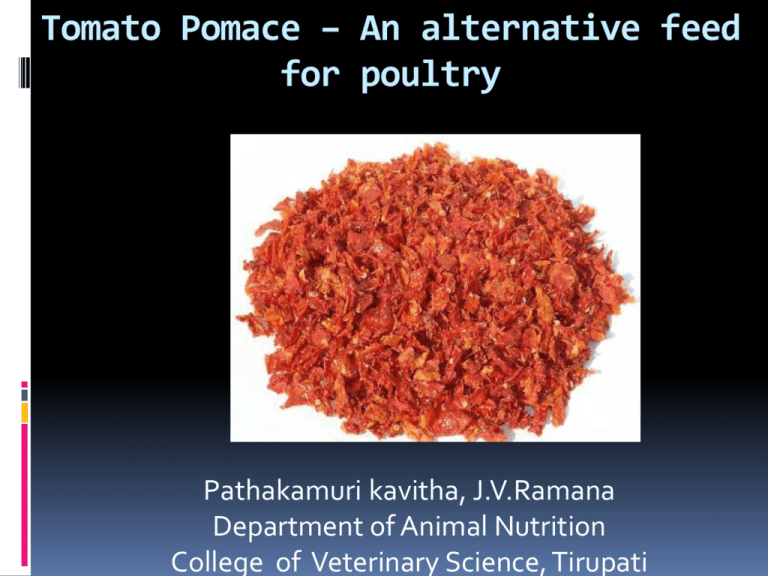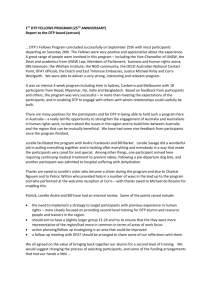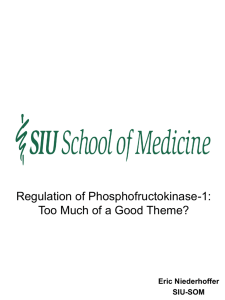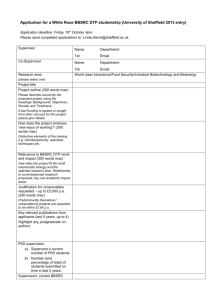Feed intake (g) Slide 1 Slide 1 Slide 1 Slide 1 Slide 1 Slide 1 Slide 1
advertisement

Tomato Pomace – An alternative feed
for poultry
Pathakamuri kavitha, J.V.Ramana
Department of Animal Nutrition
College of Veterinary Science, Tirupati
Feed cost accounts for 70-75 % of total cost of
production.
Availability and cost of feed ingradients for poultry
diets are the major problems, has prompted the
need for seeking other feed resources, especially
agricultural and industrial by-products.
In India a shortage of 25% concentrates
constituting 32% of protein requirement has been
estimated (FAO,2013).
The wastes from fruit and vegetable industry can
be used as a potential source of newer cheap feed
resources.
Tomato is one of the most important
protective food crops of India. It is grown in
0.879 M ha area with 18.227 M MT production
and 20.7 MT/ha productivity.
The major tomato producing states are Bihar,
Karnataka, Uttar Pradesh, Orissa,
Andhra Pradesh, Maharashtra, Madhya
Pradesh and West Bengal.
29% of total national production is from
Andhra Pradesh.
Tomato Production in India
(Source: Indian horticultural data base-2013)
Year
Area
(‘000 HA)
% of total
veg. area
Production
(‘000 MT)
% of total
veg.
production
Productivity
(MT/HA)
2001-02
458.1
7.4
7462.3
8.0
16.3
2002-03
478.8
7.9
7616.7
9.0
15.9
2003-04
502.8
8.0
8125.6
8.7
16.2
2004-05
505.4
7.5
8825.4
8.7
17.5
2005-06
546.1
7.6
9820.4
8.9
18.0
2006-07
596.0
7.9
10055.0
8.7
16.9
2007-08
566.0
7.2
10303.0
8.0
18.2
2008-09
599.0
7.5
11149.0
8.6
18.6
2009-10
634.4
7.9
12433.2
9.3
19.6
2010-11
865.0
10.2
16826.0
11.5
19.5
2011-12
907.1
10.1
18653.3
11.9
20.6
2012-13
879.6
9.6
18226.6
11.2
20.7
Tomato Production(‘000MT) Trend in India
20000
18000
16000
14000
12000
10000
8000
6000
4000
2000
0
Source: Indian Horticulture data base-2013
State wise production(‘000MT) of Tomato in India
State
2012-13
Andhra Pradesh
5218.1
Karnataka
1916.6
Madhya Pradesh
1845.0
Odisha
1382.78
Gujarat
1156.72
Bihar
1126.25
West Bengal
1125.6
Maharashtra
1050.0
Chhattisgarh
762.22
Himachal Pradesh
Others
413.71
Total
18226.6
2229.7
Tomato Production('000 MT)
Others
12%
Himachal
Pradesh
2%
Chattisgarh
Andhra Pradesh
29%
4%
Maharashtra
6%
West Bengal
6%
Karnataka
11%
Bihar
6%
Gujarat
6%
Odisha
8%
Madhya Pradesh
10%
Tomato Pomace
The tomato pomace is a by-product obtained from the
processing of tomatoes for concentrated paste, juice,
puree, sauce and ketchup. The solid waste which remains
after extraction process consists of peels, cores, seeds,
trimmings and cull tomatoes.
About 2% of tomatoes are processed for value added
products in India. When tomatoes are processed into
products, 10% to 30% of their weight becomes waste or
“pomace”.
According to Safamehr et al(2011 )tomato pomace
contains 90% DM, 8.1% fat, 19.68% protein and 29.75%
crude fiber. Moreover, it contains 13% more lysine than
soybean protein (AL-Betawi, 2005), a good source of
vitamin B, fair source of vitamin A and no known
antinutritive factors, and 2130 kcal/kg metabolizable
energy (NRC, 1988).
Chemical composition of DTP
Nutrient
Dry Matter (DM)
DTP
89.56
Organic Matter (OM)
90.99
Crude Protein (CP)
22.39
Ether Extract (EE)
12.23
Crude Fibre (CF)
40.10
Total Ash (TA)
9.01
Nitrogen Free Extract (NFE)
16.27
Acid Insoluble Ash (AIA)
3.63
Calcium (Ca)
0.56
Phosphorus (P)
0.48
*On dry matter basis except for DM
Ingredient composition (%) of broiler starter diets (BIS,1992)
Ingradient
Maize
T1&T2
T3 & T4
T5 & T6
T7 & T8
52
51
49.5
48
0
5
10
15
Soybean meal
30
28
26
24
Fish meal
10
10
10
10
Mineral mixture with salt
3
3
3
3
Saw dust
5
3
1.5
0
Feed additives
+
+
+
+
100
100
100
100
Dried tomato pomace
Total
Chemical composition* (%) of broiler starter diets
Constituents
T1&T2
T3 & T4
T5 & T6
T7 & T8
Dry matter
90.96
90.49
90.37
90.25
Organic matter
89.74
89.55
89.23
89.20
Crude protein
23.25
23.53
23.46
23.62
Ether extract
1.86
2.31
2.92
3.46
Crude fibre
6.81
7.43
8.36
9.21
Total ash
10.26
10.45
10.77
10.80
Nitrogen free
extract
Acid insoluble
ash
ME kcal / kg
(calculated)
Protein : Energy
ratio
Calcium
57.82
56.28
54.49
52.91
3.07
3.11
3.19
3.14
2712
2733
2738
2744
1 : 116
1 : 116
1 : 116
1 : 116
1.67
1.70
1.69
1.69
1.02
1.04
1.01
1.00
Phosphorus
Ingredient composition (%) of
broiler finisher diets
Ingradient
Maize
T1&T2
T3 & T4
T5 & T6
T7 & T8
61
59.5
58
56.5
0
5
10
15
21.5
19.5
17.5
15.5
10
10
10
10
3
3
3
3
Saw dust
4.5
3
1.5
0
* Feed
additives
+
+
+
+
100
100
100
100
Dried tomato
pomace
Soybean meal
Fish meal
Mineral
mixture with
salt
Total
Chemical composition* (%) of broiler finisher
diets
Constituents
T1&T2
T3 & T4
T5 & T6
T7 & T8
Dry matter
Organic
matter
Crude protein
Ether extract
Crude fibre
Total ash
Nitrogen free
extract
Acid insoluble
ash
ME kcal / kg
(calculated)
Protein :
Energy ratio
Calcium
Phosphorus
90.38
90.27
90.43
90.08
90.47
89.95
90.45
89.79
20.28
1.81
6.37
9.73
61.81
20.33
2.56
6.99
9.92
60.20
20.32
3.01
8.01
10.05
58.61
20.34
3.55
8.91
10.21
56.99
3.04
3.14
3.18
3.15
2781
2786
2791
2796
1 : 137
1 : 137
1 : 137
1 : 137
1.66
0.99
1.67
0.98
1.67
0.97
1.66
0.98
Composition of Polyzyme
IU / gm
Name of the enzyme
Xylanase
Phytase
Cellulase
Beta glucanase
Pectinase
Alpha – amylase
Protease
Alpha-galactosidase
Beta-galactosidase
:
:
:
:
:
:
:
:
:
8000
100
35
150
100
1500
500
800
450
1860
Effect of level of DTP inclusion in
broiler diets with or without enzyme
supplementationBody
on weight(g)
average body weight
gain (g)
1840
1820
1800
1780
Body weight(g)
1760
1740
1720
1700
1680
T1
T2
T3
T4
T5
T6
T7
T8
Effect of inclusion of different levels
of DTP on body weight gain of broilers
Body weight(g)
1810
1800
1790
1780
1770
1760
1750
1740
1730
1720
0% DTP
5% DTP
10%DTP
15% DTP
Effect of level of DTP inclusion in
broiler diets with or without enzyme
supplementationFeed
on intake
feed(g)intake (g)
3900
3850
3800
3750
3700
3650
Feed intake (g)
3600
3550
3500
3450
3400
T1
T2
T3
T4
T5
T6
T7
T8
Effect of inclusion of different levels of DTP
on feed intake(g) of broilers
Feed intake (g)
3850
3803.76
3800
3750
3697.6
3700
3661.4
3665.43
0% DTP
5% DTP
Feed intake
3650
3600
3550
10% DTP
15% DTP
Effect of level of DTP inclusion in broiler diets
with or without enzyme supplementation on feed
efficiency
Feed intake/Kg gain
2.16
2.14
2.12
2.1
2.08
2.06
Feed intake/Kg gain
2.04
2.02
2
1.98
1.96
T1
T2
T3
T4
T5
T6
T7
T8
2.16
Effect of inclusion of different levels
of DTP on feed intake/kg gain in broilers
broilers
2.14
2.14
2.12
2.11
2.1
2.08
2.06
2.06
2.04
2.04
2.02
2
1.98
0% DTP
5% DTP
10% DTP
15% DTP
Effect of level of DTP inclusion in broiler diets with or
without enzyme supplementation on level of serum
triglycerides and serum cholesterol
200
180
160
140
120
Serum Triglycerides
100
Serum Cholesterol
80
60
40
20
0
T1
T2
T3
T4
T5
T6
T7
T8
Effect of inclusion of different levels of DTP on the
level of serum triglycerides and serum cholesterol
175
170.33
170
165
163.41
160.75
160
159.2
156.2
155
154.43
Serum Triglycerides (mg/dl)
149.79
150
Serum Cholesterol (mg/dl)
145.94
145
140
135
130
0% DTP
5% DTP
10% DTP
15% DTP
Effect of level of DTP inclusion in broiler
diets with or without enzyme supplementation
on LDL-C (mg/dl)
LDL-C
35
30
25
20
LDL-C
15
10
5
0
T1
T2
T3
T4
T5
T6
T7
T8
Effect of inclusion of different levels of DTP
on the level of serum LDL-C
LDL-C mg/dl
35
30.76
30
27.6
23.96
25
20.51
20
15
10
5
0
0% DTP
5% DTP
10% DTP
15% DTP
Effect of level of DTP inclusion in broiler
diets with or without enzyme supplementation on
breast muscle cholesterol (mg/100g of meat)
70
59.33
60
52.58
57.07
50.91
54.54
50.98
49.77
50
41.15
40
30
20
10
0
T1
T2
T3
T4
T5
T6
T7
T8
Effect of level of DTP inclusion in broiler
diets on breast muscle cholesterol (mg/100g of
meat)
60
55.96
53.99
52.15
50
46.07
40
30
20
10
0
0% DTP
5% DTP
10% DTP
15% DTP
Effect of level of DTP inclusion in
broiler diets on thigh muscle cholesterol
(mg/100g of meat)
136.78
140
116.54
120
114.19
108.86
100
80
60
40
20
0
0% DTP
5% DTP
10% DTP
15% DTP
Effect of level of DTP inclusion in broiler
diets on Feed cost/kg gain
Feed cost(Rs.)/kg gain
59
58
57
56
Feed cost(Rs.)/kg gain
55
54
53
52
T1
T2
T3
T4
T5
T6
T7
T8
THANK YOU
Veysel Ayhan and Sedat Aktan (2004) suggested that
DTP can be used as a feed ingradient in broiler ration
with a level of 5%.
Melkamu Bezabih Yitbarek (2012) reported that
weight gain and feed efficiency are higher at 5% DTP
inclusion in Rhode Island Red grower chicks.
Safamehr.et al .,2011 included DTP at 0,4,8 & 12 %
levels with and without enzyme supplementation in
layer rations and observed decreased serum
cholesterol but had no effect on yolk cholesterol
with increase in the DTP level and the better
performance was observed at 8% level of inclusion.
Enzyme supplementation increased egg weight, but
did not affected the egg production.
Jafari et al(2006) and Mansoori et al (2008) reported
that feeding laying hens with diets containing DTP
at inclusion rates upto 120g/kg did not effect egg
production, food consumption and efficiency of the
hen as well as egg weight and shell thickness.
Md.Hamed Salajegheh et al (2012) reported DTP
inclusion caused a significant increase in mean HDL
cholesterol and decrease in serum LDL cholesterol
content.





